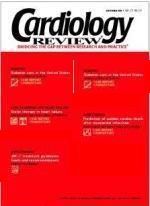Publication
Article
Cardiology Review® Online
Low-dose atorvastatin benefits cardiac transplant patients Harold L. Lazar, MD
In their study, See and colleagues (page 17) demonstrated that the use of low doses of atorvastatin (10—20 mg) early after heart transplantation decreased the incidence of new atherosclerotic coronary lesions, limited the progression of established lesions, decreased maximal coronary intimal thickness and percent area stenosis, and resulted in better preservation of endothelial function after 1 year.
These results were achieved with only mild reductions in total cho-
lesterol and low-density lipopro-
tein (LDL) levels, suggesting that these beneficial effects were due
to the pleiotropic properties of HMG-CoA reductase inhibitors (statins) on endothelial function and the inflammatory response. The authors conclude that early, aggressive statin therapy after cardiac transplantation may limit transplant-mediated coronary artery
disease, and is indicated regardless of LDL levels.
This study is one of several recent trials that have demonstrated improved outcomes in cardiac transplant patients receiving statins
during the early postoperative period. Kobashigawa and coworkers found that cardiac transplant patients receiving pravastatin (40 mg daily) had improved survival (98% versus 78%; P = .025) and fewer episodes of cardiac rejection and hemodynamic compromise (3% versus 14%; P = .005) at 1 year.1 Wenke
and associates found that cardiac transplant patients receiving simvastatin (5—20 mg) had better long-term survival (P < .006) and a lower
incidence of graft vessel disease
(P < .02) over an 8-year period.2 Mehra and colleagues found that either pravastatin (20 mg daily)
or simvastatin (10 mg daily) improved 1-year survival in cardiac transplant patients compared with
a group that received no statin therapy (P = .04).3
These studies, along with the
current study by See and colleagues, support the concept that statin
therapy started shortly after car-
diac transplantation improves survival and may decrease rejection and graft atherosclerosis. There is evidence to suggest that statins may modulate arterial gene expression.4 They inhibit T-cell activation by down-regulating major histocompatibility complex II, which is required for antigen presentation and T-cell activation. The resulting decrease in helper T-cell differentiation and activation leads to a reduction
in proinflammatory cytokines. Reductions in LDL cholesterol levels with statins have also been associated with significant increases in the unbound fraction of cyclosporine. This may explain why statins may be useful in treating graft atherosclerosis and rejection after cardiac transplantation.
Low-dose statin therapy is safe and appears to be well tolerated by cardiac transplant patients. It is unclear, however, whether using higher doses of statins to achieve LDL levels of 100 mg/dL or lower, as in the coronary artery bypass grafting patients, is safe after cardiac transplantation. In a study by Keogh and colleagues, increasing the dose of simvastatin to 40 mg daily in cardiac transplant patients was associated with an increased incidence of side effects including rhabdomyolysis.5
Conclusion
Further clinical studies will be necessary in the cardiac transplant population to determine the risks and benefits of high-dose statin
therapy in these patients. Nevertheless, I would agree with See and his colleagues that low-dose sta-
tin therapy is safe and effective and will benefit all cardiac transplant patients regardless of their baseline LDL levels.
